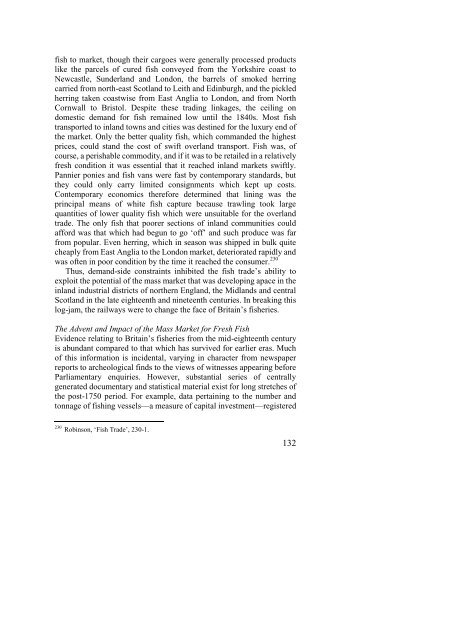The North Atlantic Fisheries, 1100-1976 - University of Hull
The North Atlantic Fisheries, 1100-1976 - University of Hull
The North Atlantic Fisheries, 1100-1976 - University of Hull
Create successful ePaper yourself
Turn your PDF publications into a flip-book with our unique Google optimized e-Paper software.
fish to market, though their cargoes were generally processed products<br />
like the parcels <strong>of</strong> cured fish conveyed from the Yorkshire coast to<br />
Newcastle, Sunderland and London, the barrels <strong>of</strong> smoked herring<br />
carried from north-east Scotland to Leith and Edinburgh, and the pickled<br />
herring taken coastwise from East Anglia to London, and from <strong>North</strong><br />
Cornwall to Bristol. Despite these trading linkages, the ceiling on<br />
domestic demand for fish remained low until the 1840s. Most fish<br />
transported to inland towns and cities was destined for the luxury end <strong>of</strong><br />
the market. Only the better quality fish, which commanded the highest<br />
prices, could stand the cost <strong>of</strong> swift overland transport. Fish was, <strong>of</strong><br />
course, a perishable commodity, and if it was to be retailed in a relatively<br />
fresh condition it was essential that it reached inland markets swiftly.<br />
Pannier ponies and fish vans were fast by contemporary standards, but<br />
they could only carry limited consignments which kept up costs.<br />
Contemporary economics therefore determined that lining was the<br />
principal means <strong>of</strong> white fish capture because trawling took large<br />
quantities <strong>of</strong> lower quality fish which were unsuitable for the overland<br />
trade. <strong>The</strong> only fish that poorer sections <strong>of</strong> inland communities could<br />
afford was that which had begun to go ‘<strong>of</strong>f’ and such produce was far<br />
from popular. Even herring, which in season was shipped in bulk quite<br />
cheaply from East Anglia to the London market, deteriorated rapidly and<br />
was <strong>of</strong>ten in poor condition by the time it reached the consumer. 230<br />
Thus, demand-side constraints inhibited the fish trade’s ability to<br />
exploit the potential <strong>of</strong> the mass market that was developing apace in the<br />
inland industrial districts <strong>of</strong> northern England, the Midlands and central<br />
Scotland in the late eighteenth and nineteenth centuries. In breaking this<br />
log-jam, the railways were to change the face <strong>of</strong> Britain’s fisheries.<br />
<strong>The</strong> Advent and Impact <strong>of</strong> the Mass Market for Fresh Fish<br />
Evidence relating to Britain’s fisheries from the mid-eighteenth century<br />
is abundant compared to that which has survived for earlier eras. Much<br />
<strong>of</strong> this information is incidental, varying in character from newspaper<br />
reports to archeological finds to the views <strong>of</strong> witnesses appearing before<br />
Parliamentary enquiries. However, substantial series <strong>of</strong> centrally<br />
generated documentary and statistical material exist for long stretches <strong>of</strong><br />
the post-1750 period. For example, data pertaining to the number and<br />
tonnage <strong>of</strong> fishing vessels—a measure <strong>of</strong> capital investment—registered<br />
230 Robinson, ‘Fish Trade’, 230-1.<br />
132















